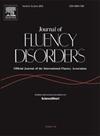调查日本成人口吃的两种语音亚型:元音-辅音视角
IF 2.1
3区 医学
Q1 AUDIOLOGY & SPEECH-LANGUAGE PATHOLOGY
引用次数: 0
摘要
口吃受到多种语言因素的影响,其中之一就是一个单词是以元音还是辅音开头。在包括英语在内的许多语言中,以辅音开头的单词更容易引起口吃,而在以元音开头的单词上口吃更频繁的人相对较少。然而,在日语中,经常观察到那些在元音开头的单词上更容易口吃的人。本研究旨在通过探索日语口吃者中是否存在以元音或辅音为特征的亚型来澄清这些不一致。15名自称口吃的成年人每人阅读190个非单词刺激,控制单词长度和熟悉程度,并在每次试验后以4分制对他们的口吃严重程度进行评分。对19种不同单词开头发音的口吃严重程度进行了分层聚类分析,发现了两个不同的集群:一个主要倾向于辅音开头口吃(集群C),另一个倾向于元音开头口吃(集群V)。随后,一个多层次有序逻辑回归模型检验了各种语音特征的影响。鼻辅音与两组口吃严重程度的降低有关,而辅音和声门因素等特征仅与c组口吃严重程度的增加有关。这些结果表明,将参与者分为元音和辅音倾向亚型可以调和之前关于日语口吃中初始音作用的矛盾发现。认识到这些亚型可能对未来的研究和临床干预至关重要,因为它强调了在调查和治疗日语和潜在的其他语言口吃时需要考虑个性化的语音敏感性。本文章由计算机程序翻译,如有差异,请以英文原文为准。
Investigating two phonological subtypes of stuttering in Japanese adults: A vowel–consonant perspective
Stuttering is influenced by various linguistic factors, one of which is whether a word begins with a vowel or a consonant. In many languages, including English, consonant-initial words are more likely to elicit stuttering, and individuals who stutter more frequently on vowel-initial words are relatively rare. However, in Japanese, individuals who tend to stutter more on vowel-initial words are frequently observed. This study aimed to clarify these inconsistencies by exploring whether subtypes exist among Japanese speakers who stutter, characterized by vowel- or consonant-oriented difficulty. Fifteen adults who self-identified as people who stutter each read 190 nonword stimuli controlled for word length and familiarity, rating their stuttering severity on a 4-point scale after each trial. A hierarchical cluster analysis of stuttering severity across 19 different word-initial sounds revealed two distinct clusters: one primarily prone to consonant-initial stuttering (Cluster C) and another prone to vowel-initial stuttering (Cluster V). Subsequently, a multilevel ordinal logistic regression model examined the effects of various phonological features. Nasal consonants were associated with reduced stuttering severity in both clusters, whereas features such as consonantal and glottal factors were linked to increased severity only in Cluster C. These results suggest that dividing participants into vowel- and consonant-prone subtypes can reconcile previous contradictory findings regarding the role of initial sounds in Japanese stuttering. Recognizing these subtypes may be critical for future research and clinical interventions, as it underscores the need to consider individualized phonological sensitivities when investigating and treating stuttering in Japanese and potentially other languages.
求助全文
通过发布文献求助,成功后即可免费获取论文全文。
去求助
来源期刊

Journal of Fluency Disorders
AUDIOLOGY & SPEECH-LANGUAGE PATHOLOGY-REHABILITATION
CiteScore
3.70
自引率
14.30%
发文量
23
审稿时长
>12 weeks
期刊介绍:
Journal of Fluency Disorders provides comprehensive coverage of clinical, experimental, and theoretical aspects of stuttering, including the latest remediation techniques. As the official journal of the International Fluency Association, the journal features full-length research and clinical reports; methodological, theoretical and philosophical articles; reviews; short communications and much more – all readily accessible and tailored to the needs of the professional.
 求助内容:
求助内容: 应助结果提醒方式:
应助结果提醒方式:


